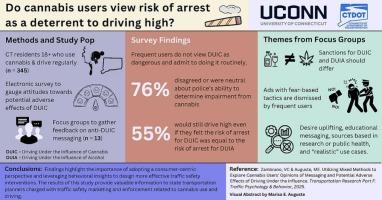在大麻的影响下驾驶:使用者的想法和为什么它很重要
IF 4.4
2区 工程技术
Q1 PSYCHOLOGY, APPLIED
Transportation Research Part F-Traffic Psychology and Behaviour
Pub Date : 2025-08-27
DOI:10.1016/j.trf.2025.103337
引用次数: 0
摘要
对全国大麻趋势的研究表明,许多美国成年人和青少年认为大麻基本上是无害的(Hasin, 2018; Hasin和Walsh, 2021),由于大麻酒后驾驶的风险,这一观点在合法化的康涅狄格州引起了关注。这些关切使我们更加迫切需要制定循证战略,主要通过有效的公共信息宣传,防止在大麻影响下驾驶。作为回应,本研究试图:(a)了解康涅狄格州的大麻使用者如何感知和参与DUIC;(b)探讨他们对DUIC的法律后果的看法;(c)确定他们认为最有效地阻止这种行为的消息传递策略。采用混合方法,包括全州范围的在线调查(n = 345)和焦点小组(n = 13)。调查结果采用描述性统计、方差分析和卡方检验进行分析,对焦点小组讨论进行专题分析。在接受调查的人中,228人表示,如果他们认为酒后驾车的风险与酒后驾车一样大,他们就会避免酒后驾车,而30人表示他们仍然会在酒后驾车。此外,262名参与者对执法部门准确检测大麻损害的能力表示怀疑,266名参与者认为DUIC应该受到与酒后驾驶不同的法律处罚。被确定为经常吸食大麻的焦点小组参与者强烈反对基于恐惧的信息传递和污名化,而是赞成通过现实情景和实际指导促进安全驾驶的运动。他们还强调了可靠来源和相关沟通的重要性。研究结果强调了以用户为中心、行为知情的交通安全战略的重要性,并为政策制定者制定与大麻相关的道路安全和教育方案提供了指导。本文章由计算机程序翻译,如有差异,请以英文原文为准。

Driving under the influence of cannabis: What users think and why it matters
Studies of national cannabis trends show many U.S. adults and adolescents see cannabis as mostly harmless (Hasin, 2018, Hasin and Walsh, 2021), a view causing concern in Connecticut amid legalization, due to risks from cannabis-impaired driving. These concerns amplified the urgent need for evidence-based strategies to prevent driving under the influence of cannabis (DUIC), primarily through effective public messaging. In response, this study sought to: (a) understand how cannabis users in Connecticut perceive and engage in DUIC; (b) explore their views on the legal consequences of DUIC; and (c) identify the messaging strategies they believe would be most effective in deterring this behavior. A mixed-methods approach was employed, incorporating a statewide online survey (n = 345) and focus groups (n = 13). Survey results were analyzed using descriptive statistics, ANOVAs, and chi-square tests, while thematic analysis was performed on focus group discussions. Among survey respondents, 228 reported they would refrain from driving high if they thought it was as risky as drunk driving, whereas 30 said they would still drive under the influence. Additionally, 262 participants expressed skepticism about law enforcement’s ability to detect cannabis impairment accurately, and 266 felt that DUIC should carry different legal penalties than drunk driving. Focus group participants identified as frequent cannabis users strongly rejected fear-based messaging and stigma, instead favoring campaigns that promoted safe driving through realistic scenarios and practical guidance. They also emphasized the importance of credible sources and relatable communication. The findings underscore the importance of user-focused, behaviorally informed traffic safety strategies and offer guidance for policymakers shaping cannabis-related road safety and education programs.
求助全文
通过发布文献求助,成功后即可免费获取论文全文。
去求助
来源期刊
CiteScore
7.60
自引率
14.60%
发文量
239
审稿时长
71 days
期刊介绍:
Transportation Research Part F: Traffic Psychology and Behaviour focuses on the behavioural and psychological aspects of traffic and transport. The aim of the journal is to enhance theory development, improve the quality of empirical studies and to stimulate the application of research findings in practice. TRF provides a focus and a means of communication for the considerable amount of research activities that are now being carried out in this field. The journal provides a forum for transportation researchers, psychologists, ergonomists, engineers and policy-makers with an interest in traffic and transport psychology.

 求助内容:
求助内容: 应助结果提醒方式:
应助结果提醒方式:


